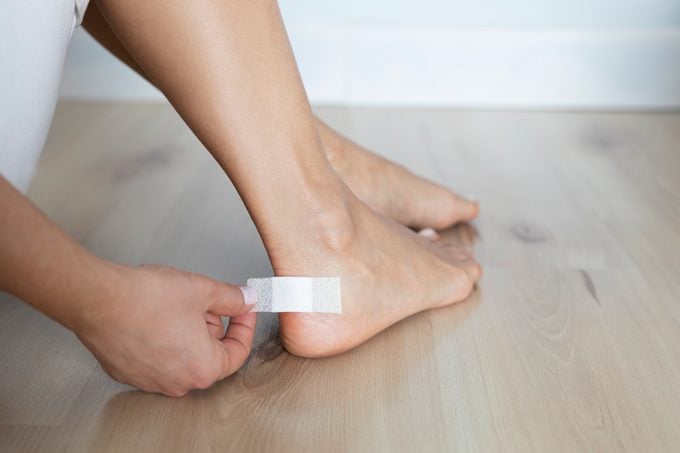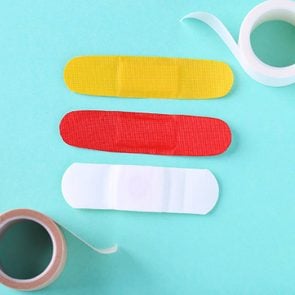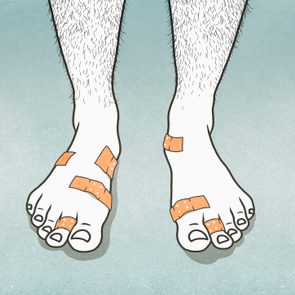What Is a Blood Blister? How to Prevent and Treat These Blisters
Updated: Oct. 13, 2020
Blood blisters are common and can occur from friction or trauma to the skin. Whatever you do, don't pop your blood blister at home.
On This Page
What are blood blisters?
After a record run, you may notice a tiny red bubble on your foot. Don’t panic. This is likely just a blood blister and not a cause for concern. Instead of being filled with clear fluid like a friction blister, blood blisters are filled with blood and have a reddish hue.
“Blood blisters are fairly common and can happen anywhere on the body that skin is pinched or traumatized,” says Deepti Gupta, MD, pediatric dermatologist, Seattle Children’s Hospital in Washington. Blood blisters tend to go away without treatment within a few weeks and do not pose any significant health risk.
Here’s what you need to know about blood blister symptoms, causes, treatments, and how you can prevent them.
Blood blister symptoms
Blood blisters may appear dark red, purple, or even black. They are usually painless, but some can cause pain or discomfort, says John Strasswimmer, MD, clinical professor of dermatology, Florida Atlantic University, in Boca Raton. “They almost always go away on their own within 1-2 weeks.” Common locations for blood blisters are hand, fingers, feet, and or near joints and bones, he adds. (Here’s what you need to know about diabetic blisters.)
Blood blisters can develop in people of all ages, even children, but older individuals may be at greater risk because blood vessels tend to grow more fragile with advancing age, says Kathryn A. Boling, MD, an internist at Mercy Medical Center in Baltimore.
As a result, these blood vessels may be more prone to damage.
Blood blister causes
Blood blisters form when blood vessels beneath the blister are damaged and blood leaks into the blister. “They result from excessive friction caused by repetitive motions, such as running long distances or constant hammering, or trauma, such as getting pinched by a toy or tool, especially if the skin is really moist,” Dr. Gupta says.
Think of it as a bruise on the top layer of your skin, adds Dr. Strasswimmer. “Normally a bruise goes deep enough inside your skin so it doesn’t lift anything up and cause a pocket, it just gives it discoloration.”
A bruise in the top layer of skin makes a bubble or blister that can fill with blood if a blood vessel is involved. (In case you’re curious, this is why blood is red.)
Other causes of blood blisters include lysosomal storage disease, a group of rare genetic diseases characterized by the unusual build-up of toxic materials in the body’s cells, according to the National Organization for Rare Disorders. This is due to enzyme deficiencies. This can cause blood blisters on your body, fingers, and toes.
“These diseases tend to manifest later in life, and the blood blisters they cause can be quite extensive,” Dr. Strasswimmer says.
Dr. Strasswimmer adds that clusters of blood blisters in the genital area may also occur. “We don’t know why, but they can be worrisome because they can look very dark and make us worry about a more severe condition such as skin cancer.”

Blood blister treatments
Whatever you do, do not pop a blood blister at home, warns Dr. Boling.
“Blood is a good medium to grow bacteria, and the skin surrounding the blood blister is protecting it from infection,” she explains. “If you puncture the blister, you do away with the barrier and it can become infected with staphylococcus bacteria, including hard-to-treat and potentially serious Methicillin-resistant Staphylococcus aureus (MRSA). You can place a Band-Aid or liquid skin over the blister to better protect it, she adds. To alleviate pain, take acetaminophen (Tylenol) or ibuprofen (Advil, Motrin).
Keep the area elevated, adds Dr. Strasswimmer. “Elevation is the most important because it lets the pressure decrease,” he says. “Ice in a thin towel can help, but for no more than 10 minutes every half hour.”
Overdoing it on ice may cause frostbite which will further aggravate your blood blister. (These home remedies can help treat friction blisters.)
When to see a doctor
Infection is the main risk of blood blisters. Signs of infection include warmth, red streaking away from the blister, and pus-like cloudy drainage, Dr. Gupta says.
See a doctor if your blood blister is painful or causing any issues with mobility, Gupta says. Your dermatologist can drain your blood blister if it is causing symptoms, but this should not be attempted at home, she cautions.
“In a doctor’s office, the procedure is sterile, and we try to keep blister skin intact to prevent infection and allow the under-skin area to heal.” Infections that do occur are treated with antibiotics, she notes.
If you have a blood blister that occurs underneath a nail, this could be particularly concerning, Dr. Strasswimmer says. This can occur after you slam a finger in a door, for example. “As the blood collection expands, it can’t bubble out and can compress the nail down to the healthy skin underneath and can cause you to lose your nail,” he says.
If a blood blister develops on your heel where the skin is thick, it may appear darker and can resemble the potentially dangerous skin cancer melanoma, he says. This can happen in avid runners or other athletes.
The medical term for this condition is talon noir, Strasswimmer says. However, unlike melanoma, talon noir, or “black heel,” is harmless and will eventually resolve on its own.
Blood blisters can appear in the mouth as a result of injury, oral herpes, stress, and oral cancer, says Saul Pressner, DMD, a dentist in New York City.
“See your dentist or doctor to properly diagnose it, and then once the proper diagnosis is made, establish an appropriate treatment plan based upon what the actual condition is,” he says.
Blood blister prevention
Blood blister prevention is possible when you wear good-fitting shoes and moisture-wicking socks to prevent any type of blister, including blood blisters, Dr. Gupta says.
These reduce friction and keep moisture away from your feet. “If you are working with tools and using a repetitive motion like hammering, wear protective gloves to reduce your chances of developing a blood blister,” she says.
Remember, if a blood blister shows up in an unusual location, see your doctor to determine the cause. Overall, blood blisters will resolve on their own without any significant health effects.
Additional resources
To learn more about blood blisters, here are a few more resources:





















